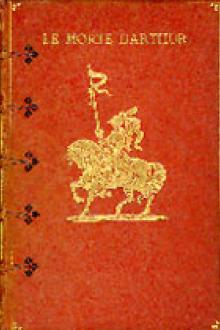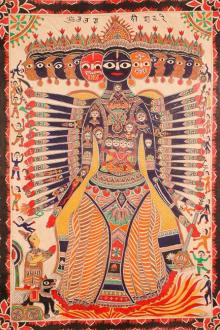Olaf the Glorious: A Story of the Viking Age, Robert Leighton [best ebook reader .TXT] 📗

- Author: Robert Leighton
Book online «Olaf the Glorious: A Story of the Viking Age, Robert Leighton [best ebook reader .TXT] 📗». Author Robert Leighton
"How can I know that what you tell is true?" asked the earl. "And what token have you to show?"
Giermund drew forth his right arm with the hand smitten off at the wrist.
"By this token may you know that these ships have come," said he.
Then Earl Hakon questioned the man closely concerning this new come enemy, and Giermund told him that the men were vikings of Jomsburg, and that they had slain many people of the land, and had robbed far and wide.
"Swiftly northward are they coming," said he, "and full eagerly, and no long time will wear by ere they are come upon you."
So thereupon the earl rowed through the firths with his fleet to meet his foes.
The Jomsvikings had sailed northward along the coast, plundering and ravaging wherever they landed. They made great coast raids, and often burned towns and hamlets. They were lying in Ulfasound, off Stad, when they and Hakon Jarl heard of each other. They were in want of food at this time, and Vagn Akison and Olaf Triggvison went on their skiff to the island of Hoed, not knowing that the earl lay in the bay near the island. Vagn and Olaf landed with their men, wishing to make a shore raid if they could, and they happened to meet a shepherd driving three cows and twelve goats.
Vagn cried to his men: "Take the cows and goats and slaughter them for our ships."
The shepherd asked: "Who commands the men on board your ship?"
"Vagn Akison, of Jomsburg," was the answer.
"I think then, that there are not very far from you bigger cattle for slaughter than my poor cows and goats," said the shepherd.
Vagn did not understand his meaning. But Olaf Triggvison looked at the man with quick apprehension, and said:
"If you know anything about the journey of Hakon Jarl, tell us at once. And if you can truthfully tell us where he is, then your cows and goats are safe."
The shepherd did not speak for many moments, but at last he answered calmly: "Jarl Hakon lay yesternight with one or two ships under shelter of the island of Hoed, and you can slay him when you like, for he is still anchored in the bay waiting for his men."
"Then your cattle are safe," rejoined Vagn. "And you shall have a good reward if you will come aboard our ship and show us the way into the bay."
Ulf--for such was the shepherd's name--went on board the skiff early in the day, and Vagn Akison, as quickly as he could, returned to the Jomsburg fleet and told the news, which spread speedily round the ships. Earl Sigvaldi at once weighed anchor and rowed out north of the island, giving word meanwhile to his vikings to make ready for battle.
Greatly did Olaf Triggvison rejoice at this immediate prospect of attacking and vanquishing the proud man who had for sixteen years held sovereign sway in Norway. If, as Ulf the shepherd had reported, Earl Hakon had but one or two ships, then it would be a very easy matter for the Jomsburgers to vanquish him, and who could tell what glorious results might not follow? Despite the fact that he was not himself the leader of this present expedition, Olaf was confident that the expected victory must bring about the furtherance of his own personal plans. It might indeed be that Earl Sigvaldi, on proving himself the easy conqueror, would attempt to place himself in possession of the realm, and to assume the name and dignity of King of Norway. But Olaf, ever hopeful and buoyant, trusted that with very little trouble on his own part, he could readily prove to the people that he, the direct descendant of Harald Fairhair, had claims of which neither Sigvaldi nor even the great Earl Hakon could justly boast.
In his passage with the viking ships up the coast of western Norway, Olaf had looked for the first time upon the wild splendour of the fiords, with their deep blue reaches of the sea penetrating far inland between steep precipices braided with sparkling waterfalls. He had seen the giant mountains rising high into the sky, with their rugged summits capped with snow and their lower slopes covered with vast forests of tall pine trees. Often some fertile valley had opened out before him, with verdant pastures and narrow strips of arable land. This was the country over which King Harald Fairhair had ruled, and now, for the first time, Olaf had realized the greatness of his heritage. He determined to fight boldly and fearlessly in this coming battle, so that he might thus win his way nearer to the possession of his birthright and the goal of his growing ambitions.
He had been placed in command of one of the largest dragonships, and while the fleet was sailing round the island--his own vessel being side by side with that of Vagn Akison--he went below and dressed himself in his strongest armour, and took up his heavy battleaxe and the well tempered sword that King Valdemar had given him. The weather was bright and warm, and he wore no cloak, but only his closely knit coat of chain mail, with his brass helmet, crested with a winged dragon, and his bossed shield. His long fair hair that fell down over his broad shoulders, his finely marked features, his beautiful blue eyes and clear ruddy complexion were on this day more evident than ever before; and his firm muscular limbs and stalwart figure distinguished him as the noblest and handsomest man in all the company of the vikings.
When he returned on deck he went at once to his post at the tiller and looked out over the blue sunlit sea. A lusty cry rose at this instant from the prow of Sigvaldi's dragonship. The fleet was now abreast of a low lying point of land at the inner coast of Hoed Isle, and it was now seen that the wide bay beyond was crowded all over with vessels of war. Ulf the shepherd had betrayed the vikings into the hands of their awaiting foe. When his treachery was discovered he ran to the rail of Vagn Akison's ship and leapt overboard, intending to swim to the shore without waiting for his reward. Vagn threw a spear at him, but missed his aim. Olaf Triggvison, who saw the shepherd swimming astern, caught up a spear with his left hand and flung it at him. It hit him in the middle and killed him.
The Jomsvikings rowed with their sixty ships into the great bay. They were formed into three divisions, and Earl Sigvaldi laid his flagship in the centre of the line of battle. To the north of him he arrayed twenty ships under the command of Bui the Thick and Sigurd Kapa, while Vagn Akison and Olaf Triggvison held the southern wing.
Earl Hakon determined which of his captains should fight against these champions. It was customary in such battles for ship to fight against ship and man against man; but in most cases Hakon, whose forces greatly outnumbered those of his enemies, placed three of his longships against one of the vikings'. He himself was not matched against any one, but had to support the whole line and command it. His son Sweyn held the chief position in the centre of battle, facing the leader of the vikings. Against the division of Bui was placed a great Norwegian warrior named Thorkel Leira. The wing held by Vagn Akison and Olaf Triggvison was opposed by Earl Hakon's eldest son, Erik. Each chief had his own banner in the shield burg at his prow.
War horns were sounded, arrows of challenge were fired over the opposing fleets, the berserks on either side clashed their arms and bit the rims of their shields, working themselves into a wild war fury. Then the fleets closed in upon each other amid a storm of arrows, and the grim battle began.
The ships of the vikings were higher in the hull than those of the Norwegians, and this gave them an advantage, for, when the grapplings were thrown out and the ships were lashed together, the Jomsburgers could fire their arrows and spears down upon the heads of their foes. The onset and attack were faultlessly made, and for a long while it seemed uncertain which side was getting the better hand. But at length Earl Hakon, who was supporting his son Sweyn against Sigvaldi, saw that his northern wing was being forced backward, and he hastened to its aid. Nevertheless, Bui the Thick still pressed the Norwegians back with heavy blows and a ceaseless rain of arrows and spears, and it seemed that at this point the vikings were quickly gaining the victory. On the southern wing, however, the fight was more equal, and Earl Erik thought that he would go to his brother's help. He went thither, accordingly, but could do no more than set the wing in line again. Hakon then returned to fight against Sigvaldi.
Now, by this short absence, Earl Erik had weakened the southern wing, and, when he came back to defend his ships, he found that Vagn Akison and Olaf Triggvison had broken through the line and made great havoc. Erik was a brave warrior, however, and he did not hesitate to make a bold attack upon the ships of these two champions. He encountered them with four of his best longships against their two. The battle at this point now grew furious, and the carnage on both sides was tremendous. Vagn and Olaf, followed by their berserks, jumped on board Erik's ship, and each went along either side of her, clearing his way, so that all fell back before the mighty blows. Erik saw that these two warriors were so fierce and mad that he would not long be able to withstand them, and that Earl Hakon's help must be got as quickly as possible. Yet he goaded his men on, and they made a brave resistance. Olaf was often attacked by three or four berserks at once, but he guarded every blow, and received but little hurt. He fought whiles with his sword and whiles with his battleaxe, and at times even with both weapons, one in either hand, dealing many hard and heavy blows, and slaying many a man. And ever when the decks were cleared there came on board other hosts of men from the neighbouring ships. Olaf wanted to come to a hand to hand combat with Earl Erik, but Erik always avoided him.
In the midst of this conflict one of Erik's men went forward and cut the lashings that bound the ships together, so that Olaf's dragonship drifted apart. Olaf noticed this, and he fought his way across the deck to where Vagn Akison was. At this moment there was a great onrush of Norwegians, and Vagn and Olaf sought the safety of one of their own ships. They jumped on board of her, and had her rowed some distance away, so that they might rest themselves and make ready for a new attack.
There was then a pause in the battle, and it was seen that Earl Hakon's ship had been taken landward, out of reach of the Jomsvikings' arrows. The legend tells that, seeing the battle going against him, he took some men ashore with him, together with his little son Erling--a lad of seven years of age. Entering a forest glade he prayed to the gods, and offered to propitiate them by making human sacrifice. When he thought that his vows and prayers were heard, he took young Erling and put him to death. Then he returned to the battle, and there was a sudden change in the weather. The sky began to darken in the north, and a heavy black cloud glided up from





Comments (0)